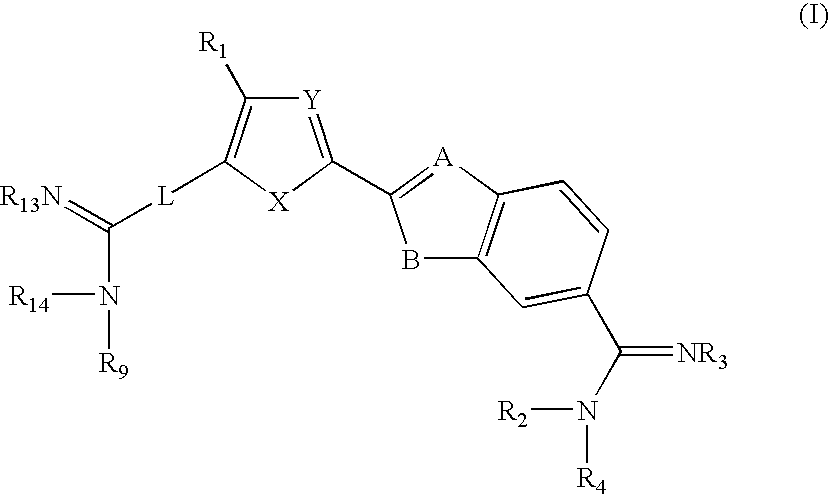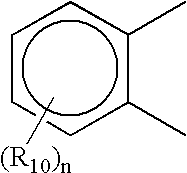Novel compounds that exhibit specific molecular recognition of mixed nucleic acid sequences and bind in the DNA minor groove as a dimer
a technology of mixed nucleic acid sequences and dimers, applied in the field of new compounds, can solve the problems of low specificity, difficult to detect, and difficult to assemble dimers, and achieve the effect of low toxicity and sensitive to compound structur
- Summary
- Abstract
- Description
- Claims
- Application Information
AI Technical Summary
Benefits of technology
Problems solved by technology
Method used
Image
Examples
example 1
Synthesis of Compounds of Formula I
[0058] 2-[5(6)-Nitro-2-benzimidazoyl]-5-(4-nitrophenyl)furan was prepared according to a modified literature procedure (R. Kada et al., Collect. Czech. Chem. Comm. 38, 1700-1704 (1973)) by reaction of 5-(4-nitrophenyl)furfural (10 mmol) with 4-nitro-1,2-phenylenediamine (10 mmol) in a mixture of DMF (25 ml) and nitrobenzene (5 ml) at 150° C. for 22 h (under nitrogen). Cooling to room-temperature gave a suspended solid which was diluted with MeOH (30 ml), collected, and finally rinsed well with ether. Yield: 2.56 g, 73%; mp 350-351° C. dec; lit mp 348-350° C.). 1H NMR (DMSO-d6): 7.51 (d, J=3.7 Hz, 1H), 7.57 (d, J=3.7 Hz, 1H), 7.78 (d, J=8.9 Hz, 1H), 7.94 (s, 1H), 8.14 (dd, J=8.9, 2.2 Hz, 1H), 8.17 (d, J=8.8 Hz, 2H), 8.36 (d, J=9.1 Hz, 2H), 8.47 (d, J=1.7 Hz, 1H) (benzimidazole NH not observed).
[0059] 2-[5(6)-Amino-2-benzimidazoyl]-5-(4-aminophenyl)furan. To a suspension of 2-[5(6)-nitro-2-benzimidazoyl]-5-(4-nitrophenyl)furan (2.63 g, 7.5 mmol) in...
example 2
DNA Fingerprinting Studies
[0068] In order to characterize the DNA recognition properties of a series of analogs of furamidine (shown in FIG. 1), quantitative DNAaseI footprinting studies were conducted using of a number of derivatives with several different DNA sequences. Plasmid DNA restriction fragments were prepared and DNaseI footprinting experiments were conducted as described in C. Bailly, et al., Biochemistry 35, 1150 (1996) and C. Bailly et al., Anti Cancer Drug Design (in press, 1999).
[0069]FIG. 2. illustrates the results of a quantitative DNase I footprinting titration experiment with the compound DB293 on a 265 bp DNA fragment as described herein. The EcoRI-PvuII restriction fragment from plasmid pBS was 3′-end labeled at the EcoRI site with [α-32P]dATP in the presence of AMV reverse transcriptase. As illustrated in FIG. 2A, the products of the DNase I digestion were resolved on an 8% polyacrylamide gel containing 8M urea. Drug concentrations are (lanes 1-11) 0, 0.3, 0....
example 3
Thermal Melting Experiments
[0072] In order to investigate the complexes of these compounds in more detail with GC rich sequences, a hairpin duplex model containing the 93-104 base sequence region from the 265 mer pBS restriction fragment was synthesized and is illustrated as oligo2 in FIG. 1. Oligo1 (also shown in FIG. 1) with the AATT sequence that has been used in the analysis of a large number of minor-groove agents provides a reference.
[0073] Thermal melting experiments were conducted with a Cary 4 spectrophotometer interfaced to a microcomputer. A thermistor fixed into a reference cuvette was used to monitor the temperature. The oligomers were added to 1 mL of buffer (0.01 M MES and 0.001M EDTA) in 1 cm path length reduced volume quartz cells, and the concentration was determined by measuring the absorbance at 260 nm. Experiments were generally conducted at a concentration of 2×10−6 M for hairpin oligo2, and 3×10−6 M for hairpin oligo2-1. Tm experiments for the complexes were...
PUM
| Property | Measurement | Unit |
|---|---|---|
| Fluorescence | aaaaa | aaaaa |
Abstract
Description
Claims
Application Information
 Login to View More
Login to View More - R&D
- Intellectual Property
- Life Sciences
- Materials
- Tech Scout
- Unparalleled Data Quality
- Higher Quality Content
- 60% Fewer Hallucinations
Browse by: Latest US Patents, China's latest patents, Technical Efficacy Thesaurus, Application Domain, Technology Topic, Popular Technical Reports.
© 2025 PatSnap. All rights reserved.Legal|Privacy policy|Modern Slavery Act Transparency Statement|Sitemap|About US| Contact US: help@patsnap.com



